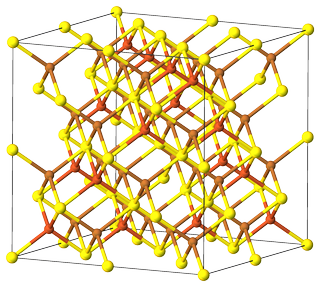Both $\ce{Cu2S.Fe2S3}$ and $\ce{CuFeS2}$ are the equivalent means to denote chalcopyrite. The first notation, $\ce{Cu2S.Fe2S3}$, commonly used a few decades ago, shows that two sulfides are not just a mechanical mix, but form a chemical compound (same as for crystallohydrates, e.g. $\ce{CuSO4 * 5 H2O}$). The second one, $\ce{CuFeS2}$, is a formula unit, a more universal and modern representation. Chalcopyrite is a mineral of $\ce{ABX2}$ type, crystallizes in $I\bar{4}2d$ space group.

Figure 1. Unit cell of chalcopyrite $\ce{CuFeS2}$. Color code: $\color{#FFFF30}{\Large\bullet}~\ce{S}$; $\color{#E06633}{\Large\bullet}~\ce{Fe}$; $\color{#C88033}{\Large\bullet}~\ce{Cu}$.
On the other hand, $\ce{Cu2FeS2}$ is a reduced formula of $\ce{Cu8Fe4S8}$, a superstructured bornite [1]. A compound of $\ce{AB2X2}$ type, crystallizes in $F\bar{4}3m$ space group.

Figure 2. Unit cell of superstructured bornite $\ce{Cu8Fe4S8}$. Color code: $\color{#FFFF30}{\Large\bullet}~\ce{S}$; $\color{#E06633}{\Large\bullet}~\ce{Fe}$; $\color{#C88033}{\Large\bullet}~\ce{Cu}$.
Structurally, chalcopyrite and superstructured bornite have very little in common. Unless there is a specific context given, I'd rather say that $\ce{Cu2FeS2}$ is an outlier among the three and is probably a typographic issue. Also, it's not a good practice to mix dot-notated formulas with formula unit representations unless one wants to underline some structural aspects (e.g. molecular assemblies/coordination polyhedra/domains etc.)
References
- Ding, Y.; Veblen, D. R.; Prewitt, C. T. Possible $\ce{Fe/Cu}$ Ordering Schemes in the 2a Superstructure of Bornite ($\ce{Cu5FeS4}$). American Mineralogist 2005, 90 (8–9), 1265–1269. https://doi.org/10.2138/am.2005.1518.


